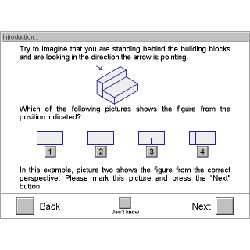
Spatial Orientation - 3D - 1 Year License
Model 64101
Non-verbal test which assesses mental imagination and transformation of spatial arrangements in three-dimensional space; applicable at the age of 15 years and over.
Test Overview
Spatial orientation, as it is assessed in this test, is an aspect of intellectual capacity providing the psychologist with essential information about the respondent which cannot be assessed with other cognitive tests. It is the ability to think in various dimensions and to organize thoughts on the basis of mental pictures.
Main Areas of Application
- performance-related aptitude diagnostics
- clinical psychology
- neuropsychology
- traffic psychology
- aviation psychology
- industrial and organizational psychology
- decisions in school, studies, and career
Theoretical Background
The primary object of measurement is the factor Spatial Ability (S) in the sense of Thurstone's theory of primary mental abilities (Thurstone, 1938). This factor was not only multiply confirmed by the factor analytics (e.g. Guilford, 1956) but also by the adherents of the hierarchical intelligence models (e.g. Spearman, 1927; Burt, 1949; Ver- non, 1950). Recent research on intelligence describes the factor as one of the "Multiple intelligences" (e.g. Gardner, 2001). Finally, Sternberg's "Three factor theory" (Sternberg, 2000) includes abilities which by definition correspond to the S-factor.
Administration
The starting stimulation of each item is a number of building blocks of the same form and size, which are joined together in different ways. One has to imagine that the building blocks are looked upon from the directionthat an arrow indicates. The testee must select a diagram that represents the bricks from this angle. The correct answer has to be chosen out of four diagram choices. The 3D consists of 30 items.
Test Forms
There is one test form.
Scoring
The number of correctly solved items constitutes the score for visualization / spatial ability. The printout shows raw- and standard- values for the total performance.
Reliability
The split-half reliability coefficients vary between r=0.82 and 0.87 for respondents with different educational levels.
Validity
The test's face validity is evident – respondents immediately associate the test with "understanding of shapes". Logical validity arises from the operational definition of what is measured. Construct validity has been demonstrated by correlation analysis. The content of 3D is similar to the content of other tests that measure spatial ability and that have good predictive validity for a variety of occupations. This confirms the predictive validity of the present test. We are currently planning our own study of the test's predictive validity.
Norms
Standardization was carried out on a representative sample of 357 individuals who were tested at the SCHUHFRIED Company's research laboratory in 2004 and 2007. A quota plan was used. These norms are also available partitioned according to gender, age and educational level.
Norms for a sample of 547 Swedish adults are also available. These norms are likewise partitioned according to gender, age, and educational level.
Testing Time
The test itself takes 3 minutes to complete. A further 2–3 minutes are required for the instructions and practice examples.
VTS System Overview
The Schuhfried VTS enables computer-assisted application of a large number of highly diverse psycho-diagnostic tests and measuring procedures. In developing the system much emphasis was placed on transparent structure and largely uniform design. It is therefore simple to operate and easy to understand and does not require any special computer skills.
The VTS basic module is required for administration of any of the available tests.
The Schuhfried VTS supports the administration of both single tests and test batteries. Many of the single tests are available in different test versions. These test versions may differ, for example, in terms of test duration or difficulty or may be parallel forms. They are characterized by different parameters reflecting specific test requirements. They have been designed for administration to a specific population (e.g. psychiatric patients, children, etc.) or for special measuring purposes (e.g. repeated measurements). Test batteries are compiled from the available single tests and test versions.
